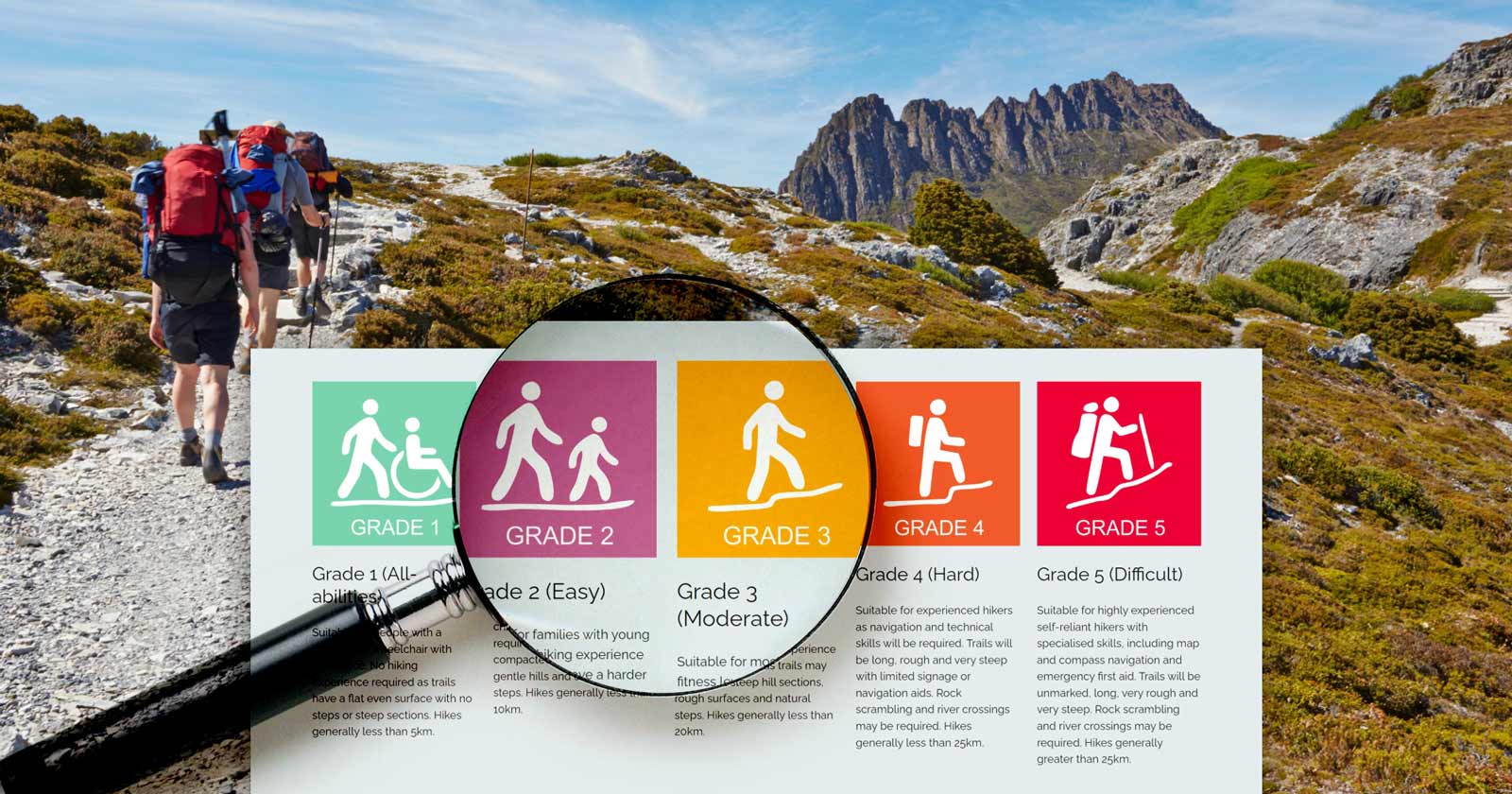Australia offers stunning landscapes and diverse trails for day hikes, but adequate preparation is essential for a safe and enjoyable experience. This guide outlines key steps to consider when you’re planning a day hike. Head out on your full day adventure better-informed and better-prepared.
Step 1: Know your limits, be honest
Self-awareness is crucial. Consider your fitness level, experience, and any health conditions that might impact your abilities. Don’t overestimate your capabilities; choose a trail that aligns with your physical limitations and comfort level. Remember, pushing beyond your limits can lead to exhaustion, injury, or even getting lost.
Key considerations for planning a day hike
Fitness: Honesty is the Best Policy
- Be honest with yourself about your current fitness level. Recent activity levels and past hiking experience are valuable indicators.
- Pushing beyond your limits can lead to physical and mental fatigue, making you vulnerable to injury, dehydration, and getting lost.
- Overestimating your capacity can lead to muscle strains, joint injuries, or sprains, potentially turning your day hike into a rescue mission.
- Disregarding your fitness level can result in frustration, discouragement, and a negative perception of hiking. Don’t let an ambitious first attempt turn you away from this rewarding activity.
Choosing a trail suited for your current fitness level ensures a safe and enjoyable experience, allowing you to build your endurance gradually and explore nature at your own pace.
Experience: Building on Past Adventures
- Consider the type of terrain and challenges you’ve encountered before. Choose a trail that matches your previous experiences.
- Unfamiliar terrain and unexpected obstacles can be daunting, especially if you haven’t encountered them before. Imagine navigating loose scree for the first time on a difficult trail, leading to anxiety and potential safety risks.
- Choosing a hike beyond your past experiences can leave you unprepared for technical sections, requiring assistance or even putting yourself in danger. Picture reaching a steep rocky section you don’t have the technical skills to traverse, potentially requiring a risky descent or rescue.
- Lack of experience might lead to packing inadequate gear for the weather, terrain or environment. I’ve seen hikers turn up for hikes in the alpine region without a outer layers or wet weather gear, and on one occasion, didn’t think they would need a fly for their tent.
Selecting a trail and environment that aligns with your past adventures allows you to gradually progress your skills and confidence, ensuring you’re equipped and prepared for the challenges you’ll face.
Health: Awareness and Precautions
- Be aware of any medical conditions that may affect your performance or require specific precautions.
- Unmanaged health conditions, like asthma or allergies, can worsen due to exertion or environmental factors, potentially requiring medical intervention on the trail. Imagine experiencing an allergic reaction miles away from help, highlighting the importance of being prepared.
- Forgetting essential medication can significantly impact your performance and well-being during the hike. Picture running out of inhaler during a strenuous climb, putting yourself at risk.
- Ignoring potential health concerns can cloud your mind with anxiety, detracting from enjoying the hike’s beauty and serenity. Imagine constantly worrying about a health condition instead of immersing yourself in the natural environment.
By being aware of your health conditions and taking necessary precautions, you can ensure a safer hiking experience, allowing you to fully appreciate the natural wonders around you.

Step 2: Choose the right trail
Researching and selecting the appropriate trail is vital. Numerous resources are available to assist you, including official park websites, hiking blogs, and guidebooks. Check maps and official sources where routes are verified, graded, accurate and up to date. Websites with verified data provide detailed information on specific trails, including distance, elevation gain, estimated duration, track conditions, and amenities. Be wary of crowd-sourced data that can sometimes be unreliable and inaccurate.
Selection criteria
Grade: Too easy, too hard or just right?
- In Australia, trails are typically categorised by difficulty, using a nationally consistent grading system known as the Walking Track Grading System. Choose a grade that aligns with your capabilities and experience (see Step 1).
- Too difficult: Choosing a trail beyond your capabilities can result in exhaustion, injury, getting lost, or needing rescue. Imagine struggling on a steep climb, running out of energy, and facing nightfall kilometres from help.
- Too easy: Selecting a trail significantly below your skill level leads to boredom, missed scenic opportunities, and a feeling of underachievement. It can also cause you to pay less attention to your surroundings and become less observant of the trail, increasing the chances of something going wrong.
Length and Elevation Gain:
- Consider the total distance and elevation gain, keeping your fitness level in mind. Plan for rest breaks and factor in slower uphill or downhill sections.
- Underestimating distance: Not accounting for the length and duration of the hike can lead to dehydration, exhaustion, and potentially getting caught out after dark. Imagine reaching a point of no return with fading light and insufficient energy to complete the hike safely.
- Ignoring elevation gain: Underestimating the uphill and downhill sections can significantly impact your pace and stamina. Picture facing steeper climbs than anticipated, leaving you breathless and struggling to enjoy the scenery.
Terrain:
- Be aware of the terrain type; for example, rocky paths, loose scree, or river crossings may require additional skills or equipment.
- Unprepared for technicality: Unfamiliarity with rocky paths, scree slopes, or river crossings can lead to falls, injuries, and equipment damage. Imagine encountering loose scree without proper footwear, causing ankle instability and potential injury.
- Packing inadequately: Lack of awareness of terrain can lead to inappropriate gear choices, hindering your progress and enjoyment. Imagine tackling a rocky scramble in flimsy sandals (yes I have seen this), risking twisted ankles and lost grip.
Facilities:
- Determine if toilets, water access, or mobile phone reception are available. Pack accordingly if amenities are limited.
- Dehydration: Neglecting to check water availability can lead to dehydration, especially on hot days or long hikes. Imagine running out of water halfway through and experiencing fatigue, headaches, and potential serious health risks.
- Sanitation issues: Not knowing about toilet facilities can leave you unprepared and uncomfortable. Picture being caught without options in the wilderness, leading to hygiene concerns and potential environmental impact.
- Communication blackout: Assuming phone reception without verifying can leave you isolated in case of emergencies. Imagine experiencing an injury or needing help but being unable to call for assistance (000) due to lack of signal. Or relying on a phone app to navigate and the batteries fail or online maps don’t work.
Weather:
- Research the expected weather conditions, including potential for rain, high winds, snow, or extreme temperatures. Choose a trail suitable for the forecast and be prepared to change or cancel your plans if the conditions worsen. Rescues occur often in extreme temperatures due to questionable planning.
- Caught in harsh conditions: Ignoring weather forecasts can expose you to unexpected rain, wind, or extreme temperatures. Imagine being caught in a sudden downpour without rain gear, leading to hypothermia and discomfort.
- Safety risks: Underestimating wind or lightning dangers can put you at risk of injury or even death. Picture encountering strong winds on an exposed peak or facing lightning strikes without knowing where to seek shelter.
Remember, considering these trail selection criteria before your hike ensures you’re better-prepared for the specific challenges and enjoy a safe and memorable outdoor experience.

Step 3: Gear selection
Pack only what you need, focusing on essential items to keep your weight manageable and your hike more comfortable and enjoyable.
Recommended essential gear
- Day pack: Choose a comfortable pack with sufficient capacity for your chosen hike.
- Navigation: Carry a physical map and compass, and know how to use them. While apps can be helpful tools, relying solely on them can be risky. Carrying a physical map and compass, and knowing how to use them, provides essential backup navigation in case of app malfunctions or unforeseen circumstances. Consider a GPS device as an additional safety net, offering greater accuracy and independence from data or phone battery limitations. Remember, mastering traditional navigation skills empowers you to confidently handle unexpected situations and ensures a safe and enjoyable journey regardless of digital hiccups.
- Hydration: Bring a reusable water bottle or hydration bladder, ensuring enough water for the entire hike and factoring in weather conditions.
- Sun protection: Australia’s sunshine is beautiful, but its UV rays can be fierce. Pack sunscreen, a wide-brimmed hat, and sunglasses.
- First-aid kit: Assemble a basic first aid kit containing essential medical supplies like bandages, antiseptic wipes, pain medication, and a space blanket (emergency blanket).
- Food and snacks: Pack enough high-energy food and snacks to maintain your energy levels throughout the hike.
- Headlamp: Even on day hikes, pack a headlamp or torch in case you get delayed or nightfall occurs unexpectedly.
- Emergency communication: Carry a mobile phone (if reception is available) for emergencies. For true peace of mind, especially in areas with unreliable service, consider investing in a personal locator beacon (PLB) or a satellite communicator. PLBs send distress signals directly to search and rescue teams, while satellite communicators offer two-way messaging, allowing you to send detailed help requests and receive updates on assistance.
Additional considerations
- Clothing: Dress in layers, choosing quick-drying and breathable materials suitable for the expected weather. Wear sturdy hiking boots with good ankle support.
- Weather protection: Pack rain gear, even if the forecast seems fair. Weather in Australia can change rapidly.
- Personal items: Include insect repellent, toilet paper, hand sanitiser, and a whistle and mirror for signaling help.
- Pack it in, pack it out: Plan to bring all your trash, food scraps and waste back with you, even biodegradable items like fruit peels. Dispose of them properly once you leave the trail. Leave No Trace and leave nature how you found it.
- Human waste disposal: Plan to pack out all your waste, even human waste. If you are unable to, and toilets not available, practice Leave No Trace principles for human waste. Dig a cathole 15-20 cm deep at least 100 meters from water sources and trails. Bury waste and toilet paper, then disguise the hole with soil and leaves. Dispose of sanitary products and feminine hygiene items responsibly by packing them out for proper disposal.

Step 4: Let someone know your plans
Inform a trusted friend or family member about your planned hike. This simple step of letting someone know before you go can be crucial in case of unexpected delays or emergencies. For shorter, less challenging hikes, as a minimum include:
- The official trail name and location
- Your expected start and finish times
- Who you are going with (if anyone)
- Your emergency contact information
For longer, more challenging and remote adventures, complete an online trip intentions form. You can use the one I’ve prepared here.
After your hike, make sure you let your contact/s know you have returned so they don’t accidentally raise the alarm.

Step 5: Preparing an emergency plan
Anticipate potential challenges, pack accordingly and plan for what could go wrong. Conducting a thorough hiking risk assessment before setting out on any hiking trip can help you identify potential hazards and develop strategies to mitigate those risks.
- Know the official trail and park name: Accurately knowing the track you plan to hike and the park it resides in allows for clearer communication with emergency services or search and rescue teams if needed.
- Plan your route: Use a scaled topographic map or download and study official trail maps, highlighting your planned route and key points of interest. Mark alternative routes or escape options in case of unforeseen obstacles.
- Identify key topographic features: Familiarise yourself with the elevation profile, steep sections, and any significant landmarks or points of reference visible from the trail. Understanding topographic features and the terrain helps with navigation and anticipating potential challenges.
- Know any water procurement points: If natural water sources like streams are present, research their safety for drinking and plan accordingly. Carry water treatment tablets or filters if relying on natural sources. If you don’t have any way to purify water, don’t be afraid to drink from rivers and streams if you are becoming dehydrated. I’ve been on search an rescue incidents where hikers had called for help, extremely dehydrated, standing next to a river.
- Learn the names of intersecting tracks or roads: Knowing connecting trails or nearby roads provides alternative options or potential evacuation routes if needed.
- Identify possible emergency evacuation/extraction points: Research potential exit points like helicopter landing zones or mark management access tracks that could be crucial in case of serious injury or emergency situations.
- Review first-aid skills: Refresh your memory on basic first-aid procedures relevant to hiking injuries like blisters, sprains, and cuts. Consider carrying a more comprehensive first-aid and survival kit if venturing into remote areas.
- Practice using your navigation tools: Before your hike, practice using your map, compass, and any GPS device you might be carrying. Get comfortable with basic navigation techniques to ensure confidence and clarity on the trail. There’s no point carrying gear if you don’t know how to use it.
- Conduct a risk assessment: Don’t just rely on general safety tips – tailor your preparation to the specific risks of your chosen hike and the Australian environment. For a detailed guide on conducting a risk assessment specifically for your Australian hike, head over to my dedicated blog post.
- Emergency procedures: Familiarise yourself with local emergency procedures and phone numbers (000 in Australia). Download helpful resources like offline maps or park safety guides.
By proactively preparing for potential setbacks and emergencies, and gathering detailed information about your chosen trail, you significantly increase your safety and peace of mind, allowing you to focus on enjoying the adventure. Remember, knowledge is power, and being prepared empowers you to handle unexpected situations calmly and effectively.
Remember, even a small investment in preparation can significantly enhance your safety and peace of mind while hiking.

Time commitment for day hike planning
Before we dive in, a quick word of caution: Mobile app use is now the top reason people become lost in the bush. While downloading a hiking app can be a helpful first step, don’t rely solely on it. Investing time in proper planning, beyond just trusting an app, is crucial for your safety and enjoyment. This ensures you’re prepared for various challenges, choose a suitable trail, and make informed decisions on the go.
The amount of time you’ll need to invest in planning your day hike doesn’t have to be an all-day affair. It varies depending on several factors, including:
- Hike difficulty: Naturally, more challenging trails (Grades 4-5) generally require more research and preparation.
- Length and duration: Longer hikes may involve more logistical considerations and potential challenges to anticipate.
- Weather: Researching specific weather forecasts and packing accordingly requires additional time.
- Remoteness of the trail: Understanding access, facilities, and potential communication limitations in more remote areas is crucial.
Here’s a general suggestion to get you started, remembering these factors above might influence your planning time:
- Easy Day Hikes (Grade 2): 45 minutes – 1 hour
- Moderate Day Hikes (Grade 3): 1 – 2 hours
- Hard Hikes (Grade 4): 2 – 3 hours (consider adding more time for thorough research, especially if unfamiliar with the area)
- Difficult Hikes (Grade 5): 4+ hours (extensive research highly recommended)
Remember, these are just starting points. The actual time you spend planning may vary based on your personal research style, familiarity with the area, and desired level of detail. Don’t hesitate to invest more time, especially for higher difficulty hikes or unfamiliar regions, to ensure a safe and enjoyable adventure.
I know this seems a lot, particularly if you are just new to hiking. I find planning a hike is all art of the journey and it certainly never feels like a chore. Ultimately how prepared you choose to be us up to you, but remember, improper planning can lead to situations requiring search and rescue assistance, diverting resources from other emergencies. By investing time in planning, you increase your chances of a safe, enjoyable, and self-sufficient hike, minimising the need for external assistance.
By following these comprehensive steps, you’ll be better-prepared for a day hike in Australia’s stunning landscapes, regardless of how much time you spend planning. The most important thing is to feel confident and comfortable with your level of preparation before heading out on your chosen trail.
















